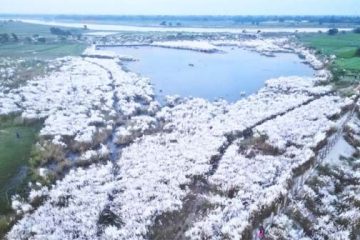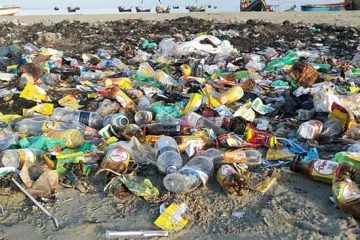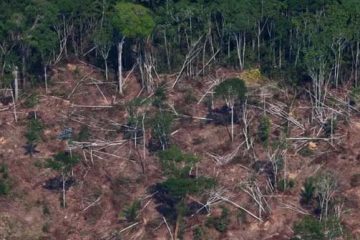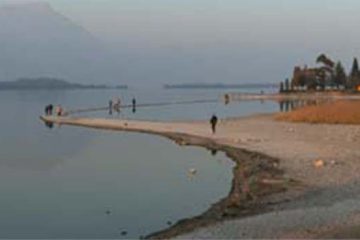Prof Mustafizur Rahman Tarafdar
 The water of Buriganga, Balu, Sitalakhya and Turag are severely polluted. No biological survival can occur there as oxygen is depleted and might have reached nearly O level! Oxygen level in fresh river water is 9mg/l at 20ºc and 7.6mg/l at 30ºc (Summer).
The water of Buriganga, Balu, Sitalakhya and Turag are severely polluted. No biological survival can occur there as oxygen is depleted and might have reached nearly O level! Oxygen level in fresh river water is 9mg/l at 20ºc and 7.6mg/l at 30ºc (Summer).
BOD5 (consumption of oxygen for decomposition of microbs) indicates organic pollution. River Buriganga receives the following types of sewage.
Nature of Sewage BOD5, mg/l
Strong Sewage 450-550
Average Sewage 350-400
The sewage of 400 mg/l, and higher BODs shows mixing of industrial effluent with domestic sewage. Untreated industrial effluent is discharged from the dispersed and cluster of industries. Most industries do not have in-house treatment plants, and even if some of them had it, they would not use it perhaps to save operation cost in blatant violation of environmental rules without any concern for pollution of the rivers.
Industrial waste should not be allowed to enter the domestic sewage network as it interferers with treatment plants. In fact there is only one sewage treatment plant at Pagla for treating domestic wastes, operated by WASA with capacity of 0.12x106m3/d. Industries should be responsible for treating their own waste in-house. The city may have up to a dozen or more such domestic sewage treatment plants.
Hazaribagh’s 500 tanneries including 200 large units discharge daily 4950 m3 of obnoxious organic wastes which is a major factor for causing severe pollution in the Buriganga. The waste near Hazaribagh penetrates horizontally in underground aquifers causing groundwater pollution, a new and dangerous phenomenon, which is reported only recently. 700 different industrial units discharge untreated effluents of 1.3 million cubic metre. Millions of cubic meters of domestic sewage is generated daily of which a good portion enters Buriganga. WASA’s only treatment plant at Pagla, treats 0.12 million m3/day.
Poor people bathe in, even drink the polluted water and suffer from diarrhea, dysentery, cholera, hepatitis, jaundice, skin disease etc.
At present WASA’s 514 and other tubewells pump 1800 million litres per day, Saidabad plants provide 225 million litres and Chadnighat 39 million which is much short of the present requirement. But already these extractions are causing fall in ground water level.
On an average nearly 2m fall of GW level annually is alarming. Continuous withdrawal of GW from aquifers with attendant fall of GWL renders the trillions of pores of soils dry and empty which may accentuate subsidence of aquifer layers for self-weight of overburden layers above. The phenomenon of subsidence though a long-term process but it is real with impending danger in the near future. For this, the use of surface water for the city water supply becomes an urgent necessity.
Treatment of polluted groundwater
WASA undertakes the treatment of surface water at Saidabad Plant with intake from the Sitalakhya. For heavy organic pollution treated water supplied in March/April was tinted and odorous which almost created a stir in media with public reaction.
Reportedly groundwater is also becoming polluted in area near Hazaribagh. May be in near future we will have to treat GW for removal of Co2 by lime treatment and suspended solids by pressure filtration plants which will also remove iron (Fe) and water should be chlorinated for disinfection.
Some clean rivers in the world
The Siene by Paris, a city of 8-10 million people and industrial and commercial centre is a fresh flowing river. It is not only environmental rules which are strictly enforced and monitored, more importantly, people are aware about danger of pollution and shoulder responsibility to keep the environment clean and river free from pollution. The Nile river is the lifeline of Egypt in general and Cairo in particular. All environmental and economic activities revolve around the river. With nearly 20 million people, in the city, the river water and environment are clean and congenial. During Pharaohs time the river was revered as a ‘river god’. The river was clean then and it is now after thousands of years.
Buriganga conservancy commission
A Commission/authority is suggested by eminent experts in their recent deliberations with The Daily Star. The proposed Buriganga Conservancy Commission will be exclusively responsible for improving quantity and quality of flow and rejuvenate the river Buriganga, Balu, Sitalakhya and Turag from pollution by long term plan like the river near Singapore which took 7-8 years for its rejuvenation and got it free from pollution. The Commission will be responsible for water, sewage treatment and disposal and pollution control of the rivers.
There is Ganga Commission for the Ganges and Hoogly Commission for the Hoogly river near Calcutta. River Thames Conservancy Commission (or Authority, I am not sure). So exclusive river Basin Commissions are not new.
The Buriganga Conservancy Commission should have power and authority to undertake or assert to suggest enacting/strengthening law/regulations, identifying causes and sources of pollution, domestic sewage and industrial effluent, monitoring problems, and identifying defaulters and take punitive measures for the polluters. It should impose, mandatory in-house waste treatment for each industry or a group/cluster of industries and continuously monitor their activities. The Commission should quickly take steps to relocate hundreds of tanneries at Hazaribagh elsewhere (Savar) away from Dhaka.
Ministry of Environment is responsible for the overall issue of environment for the whole country and the proposed Buriganga Commission will be solely responsible for rivers and water bodies in the greater Dhaka city.
Long distance transportation of water
Since all the rivers around Dhaka are biologically dead and groundwater is severely exploited causing fall of WL by about 2m annually with fear of land subsidence and possible upheaval during earthquake, experts are proposing to transport fresh water from long distance for the existing treatment plants and the future plants at designed locations around the city.
Side by side attempts should be made to clean the river from further pollution by stopping/banning indiscriminate disposal of domestic raw sewage and industrial effluents. Laws should be strictly imposed, monitored and industries made to comply with or before face penalty/fines. The Tipaimukh dam under construction in India may render the Surma, Kushyara, Meghna river system dry during the lean season (Dec-May). Without ensuring equitable and fair share of water of Barak-Surma-Kushyara by quick bilateral negotiation with India, transportation of water from the Meghna may be ruled out.
Water from the Padma needs to be pumped on adverse slope to Dhaka. Continuous pumping may face logistic problem. There will be erratic power supply. Separate power station is costly in construction as well as operation for many reasons. The project may not be feasible and should be discouraged. Only feasible solution is, therefore, transporting water from Jamuna by gravity canal with intake at a suitable point, so that canal cost becomes minimum. Water will be flowing through Turag to Buriganga, through Tongi Khal to Balu and from Balu to Sitalakhya. Water should be transported from Turag point which is not yet polluted by separate pipelines to treatment plants set at required designed points around Dhaka City.
However, a designed part of the transported water should be allowed to flow through Turag to Buriganga and Tongi Khal to Balu and Sitalakhya to flush the rivers of pollution by diluting process of self-cleansing of river. Side by side disposal of untreated domestic sewage and industrial effluents should not be allowed to enter the Buriganga, Turag, Balu and Sitalakhya. Over the years, the rivers will be clean and rejuvenated.
One of the main mandates of the proposed Buriganga Commission will be to take up steps to clean the rivers by taking long term plans and bring fresh water from Jamuna by canals. Works will involve banning the disposal of domestic sewage and untreated industrial effluents and quick relocation of Hazaribagh tanneries, on lands given at subsidised rate, bearing part of relocation cost, which may mean to give some incentives to tannery owners to leave Hazaribagh quickly.
Inter-basin water transportation in other countries
There are instances of transporting water from mountainous northern California to water-starved deserts in the southern California around Los Angeles through a 600 mile concrete water tunnel. In Libya water is pumped by tubewells some kilometres deep in the very bosom of the Great Sahara desert and then transported northwards by thousands of km long tunnels/link canals to cities like Tripoli and Bengazi. The writer participated in the design of a water transfer project by construction of a dam on the famous Congo river in Zaire, construction of tunnels, link canals and large pumping stations, canals traveling thousands of km to lake Chad, bordering Nigeria, Cameroun, Niger and Chad.
Concluding remarks
Pollution points of domestic sewage and industrial waste should be identified and barred from further polluting the rivers Buriganga, Balu, Sitalakhya and Turag. Violators should be identified and monitored to impose punitive measures, such as fines or jails or cancellation of license of business to the defaulters. There should be in-house treatment for both dispersed and cluster of industries. Domestic waste must be treated in treatment plants. Treatment plants should be established at more stations than Pagla, so also separate pipelines for storm drainage.
More treatment plants like the one at Saidabad will be needed when water will be transported from the Jamuna. Gradually, groundwater pumping should be phased out. World’s some of the great clean rivers flowing by great cities should be as examples as to shown how public aversion to pollution and environmental degradation can keep them clean and safe against health hazards. Examples are the river Seine by Paris, Nile by Cairo, Mekong all way from source via Vientiane and Savanakhet to Cambodian border, Niger upto estuary etc.
Soon the government may set up a conservancy commission with the sole responsibility of looking after the health of the rivers Buriganga, Balu, Sitalakhya and Turag. Savar and Gazipur should be included in this project. Commission will monitor violator of pollution control and impose punitive measures. The commission should be autonomous with necessary administrative power and finance management.
The writer, a water specialist, is a professor of civil engineering at World University of Bangladesh, Dhaka.





